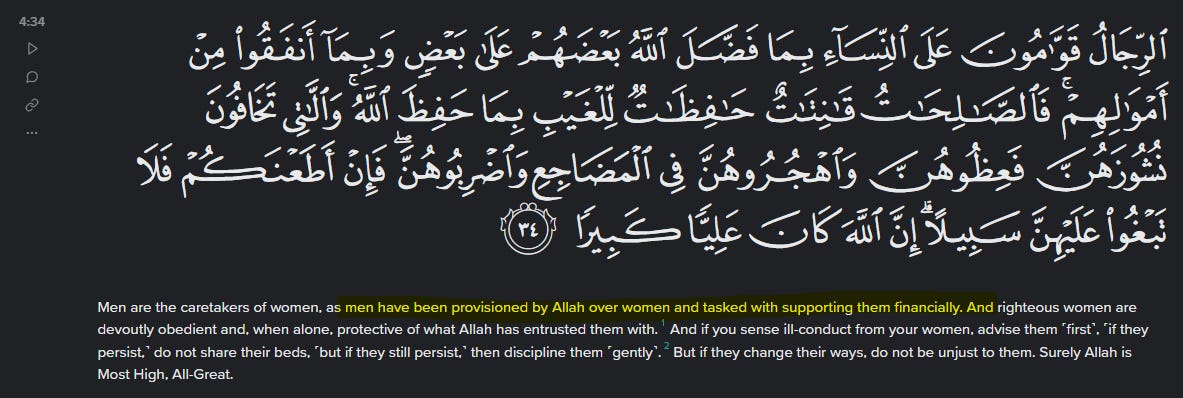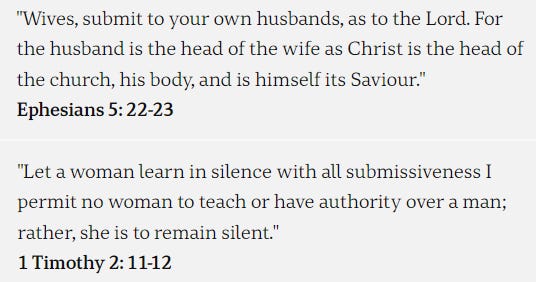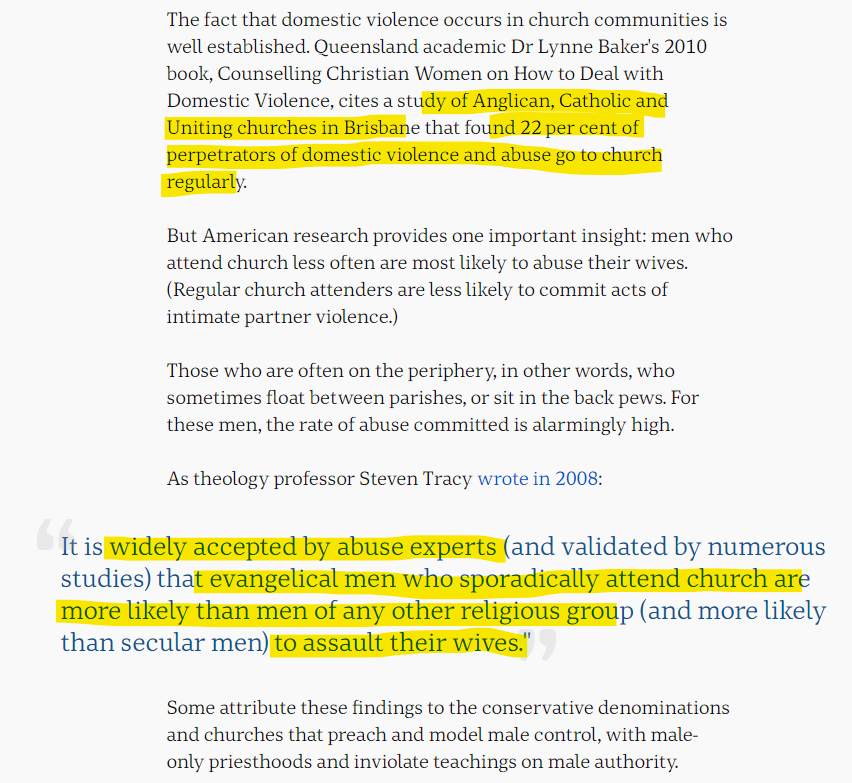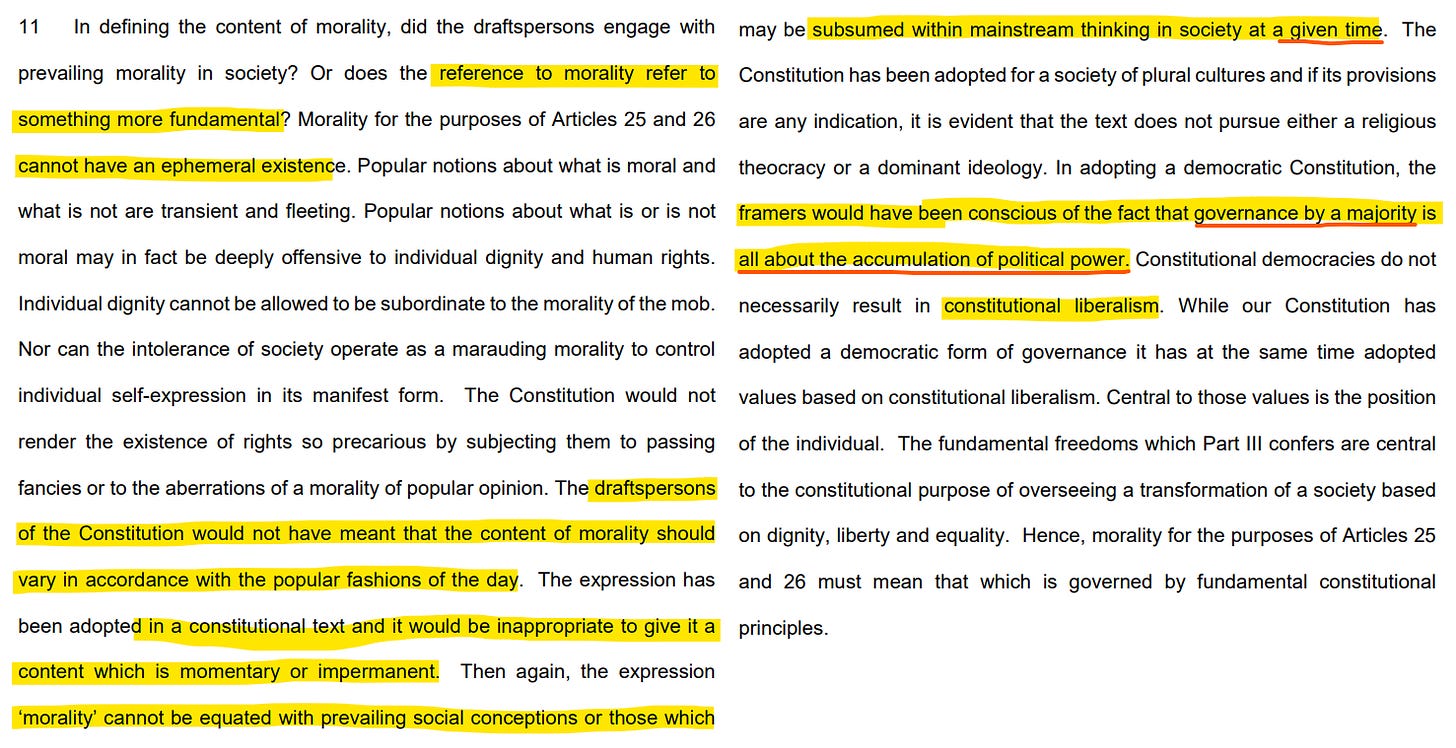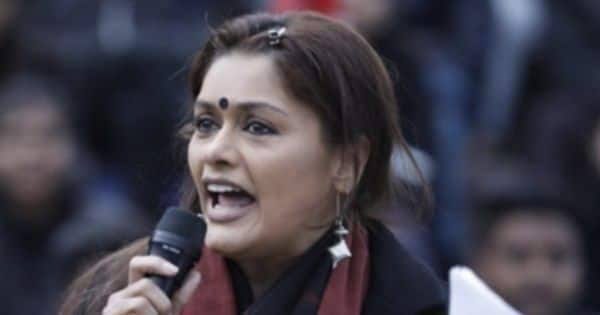Drishtikone Newsletter #337: The Procrustean Indian Judiciary System
When the judiciary becomes a group of moral busybodies without challenge, then freedoms suffer and democracy remains a sham. Evaluating the deep dangers of the Indian system.
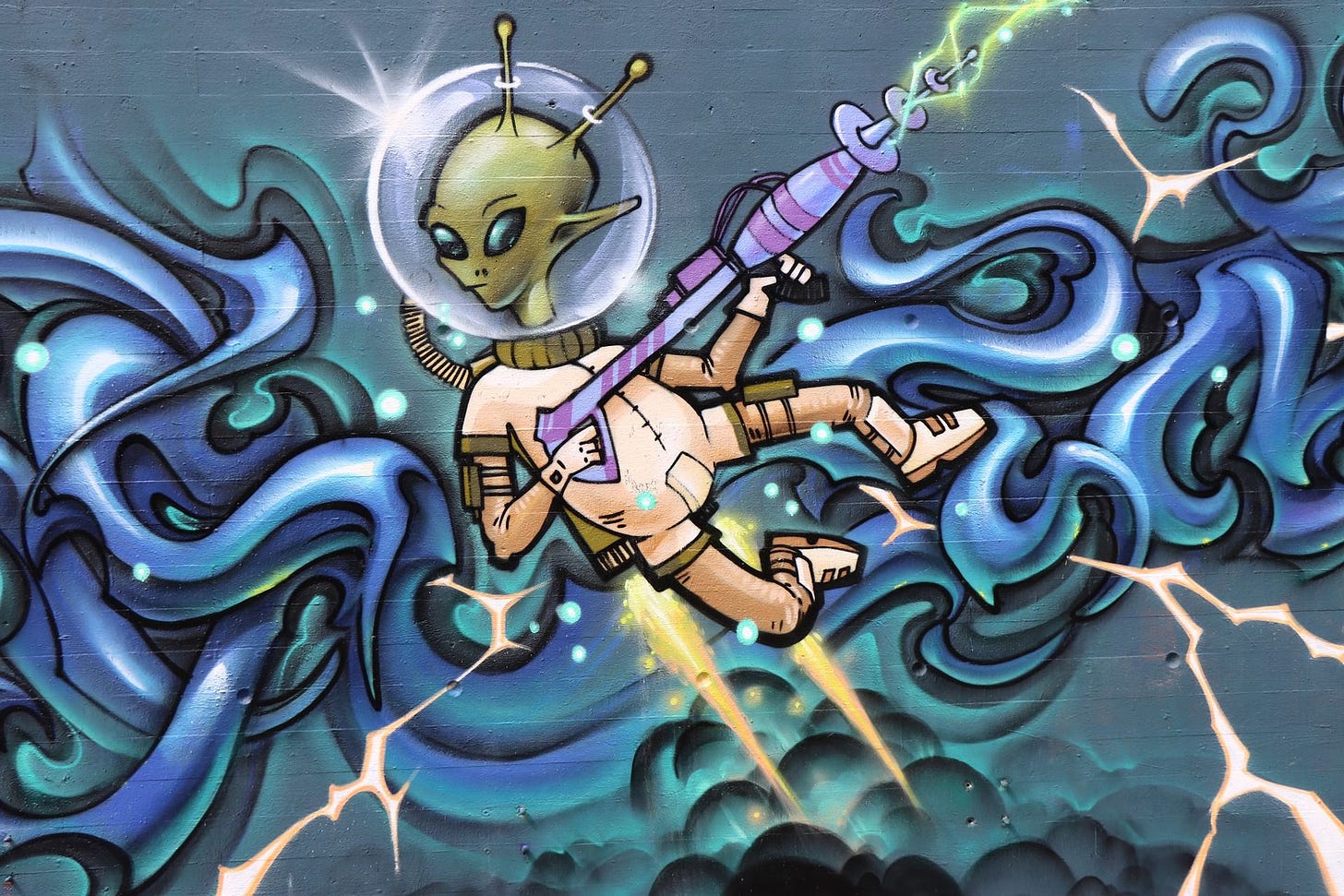
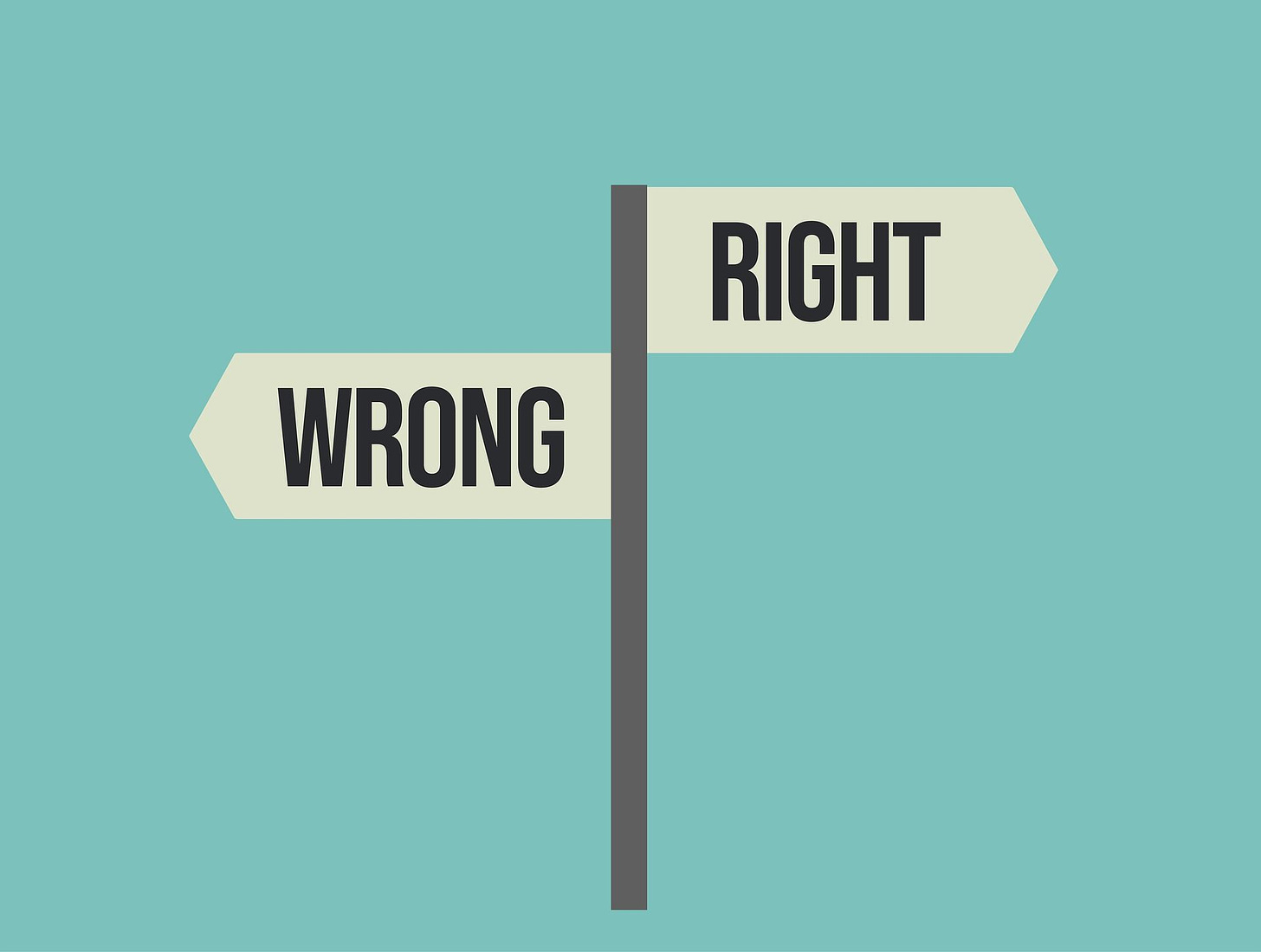
“In keeping silent about evil, in burying it so deep within us that no sign of it appears on the surface, we are implanting it, and it will rise up a thousand fold in the future. When we neither punish nor reproach evildoers, we are not simply protecting their trivial old age, we are thereby ripping the foundations of justice from beneath new generations.” ― Aleksandr I. Solzhenitsyn, The Gulag Archipelago 1918–1956
Morality is the greatest impediment to Civilization. For, it has to have an authority that decides it. No Morality is without a Sponsor. And, in that sponsorship lies the doom of those on whom it has been forced upon. For their own good.
Morality, with its sponsorship, and the swagger of that authority, creates repression. A method of control.
What use, after all, is a moral edict when it cannot be forced with all its legitimacy derived from the power of the elite?
No matter how lofty the words, the ideals, and the intent. Just the act of My word/ideal over yours is the beginning of repression, suppression, and imperialism.
When such repression, on the back of Moral justifications, is unleashed for the good of the victims, it seeks complete and absolute power. With no accountability whatsoever. Even the slightest modicum of challenge can bring down the Moral edifice that the do-gooder busybodies have erected out of their altruistic tendencies. And, that is an unacceptable act.
For Morality of a few has to reign supreme. It must be made to be so. For our own good, of course!
The Elitist Universalism of the Few for the all
On September 28th, 2018, a few wise men came together while delivering a very important note - that would change a set of observances held for many a millennium - to share what they thought were "Universal facts and Truths" about religion, God, and faith. Basically what they made of what the religions say.
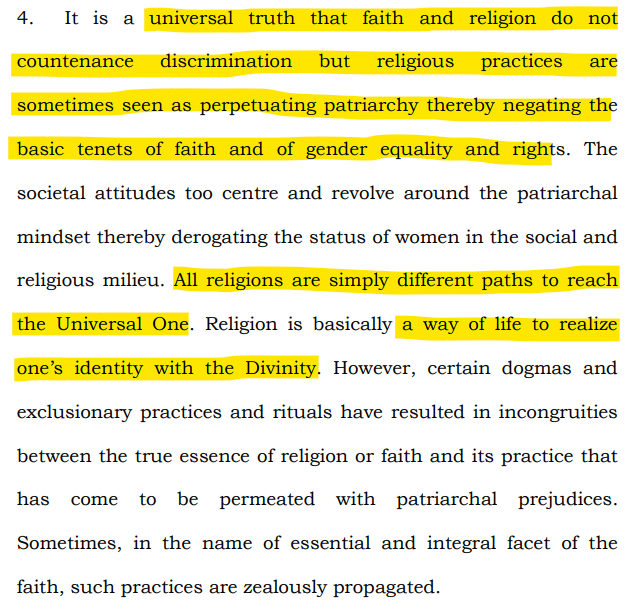
As hifalutin as these words sound, let us evaluate them in the light of reality and facts. After all, the men who delivered these words, have some relationship to relating their opinions to the evidence available, or so they boast to the lesser mortals.
Evaluating the hifalutin philosophy
The Nicene Creed is central to Christian theology.
Nicene Creed, also called Niceno-Constantinopolitan Creed, a Christian statement of faith that is the only ecumenical creed because it is accepted as authoritative by the Roman Catholic, Eastern Orthodox, Anglican, and major Protestant churches. (Source - Britannica)
It was originally written in Greek. The modern English translation of the Nicene Creed starts with the words:
I believe in one God,
the Father almighty,
maker of heaven and earth,
of all things visible and invisible.
I believe in one Lord Jesus Christ,
the Only Begotten Son of God,
born of the Father before all ages. (Source)
Belief in Jesus Christ is a critical requirement for the Christian faith. Jesus is not only the "Son of God," but the "Only Son of God." Nicene Creed is one of the Christian creeds. Others, like Chalcedonian Creed or The Apostles Creed (the oldest one) also affirm that Jesus is the "Only Son of God."
Luke 4:41 and Mark 3:11 - Jesus casts out demons. The demons then fall down before him, and declare: "You are the Son of God."
So Christian religion is very clear about its definition of God and what the goal of any Christian is.
Qur'an 5.72 says this about Jesus.
"They indeed are disbelievers those who say, ‘Indeed God is the Messiah, son of Mary’ (a similar verse has preceded [Q. 5:17]). For the Messiah said, to them, ‘O Children of Israel, worship God, my Lord and your Lord, for, I am a servant and not a god. Verily he who associates anything with God, in worship, for him God has made Paradise forbidden, He has forbidden him admittance to it, and his abode shall be the Fire; and for wrongdoers (wa-mā li’l-zālimīna min, the min is extra) there shall be no helpers’, to guard them against the chastisement of God." (Jalal - Al-Jalalayn - Source)
We have an interesting situation on our hands don't we? With respect to the "Universal Truths".
Per Islamic God - Allah - those who believe Jesus, Son of Mary, was God are to be considered "disbelievers" and paradise will be forbidden to them. On the other hand, Christians are very clear that the one and only Son of God (and therefore God himself in flesh) is Jesus Christ and no other.
So much for the imagined unanimity with respect to what religions actually say. Not what the keepers of our morality would have us believe.
Now, let us understand how much of a "Universal Truth" is that faith and religion do not countenance "discrimination."
Women and religion
In Quran Surah An-Nisa 4:34, Allah tells Muhammad that "Men are in charge of women, because Allah hath made the one of them to excel the other, and because they spend of their property (for the support of women). So good women are the obedient, guarding in secret that which Allah hath guarded. As for those from whom ye fear rebellion, admonish them and banish them to beds apart, and scourge them. Then if they obey you, seek not a way against them. Lo! Allah is ever High, Exalted, Great." (Pickthall - Source)
As for the Bible, the crux of the nature of men-women relations is in the Genesis.
The LORD God said, "It is not good for the man to be alone. I will make a helper suitable for him." (NIV, Genesis 2:18) (Source)
Also here is some other verses which speak about the situation of women.
In fact, many studies have found a clear link between those attending Church and having evangelical beliefs and abuse of women.
Where does all this leave the hifalutin words of those wise men?
Nowhere.
First off, there is no such thing as "All religions are simply different paths to reach the Universal One", because what one calls the "Universal One" is abused by another as the very reason for damnation!
Second, sorry to break it to these wise men, what they have considered as the "Universal truth that faith and religion do not countenance discrimination... " - is just plain falsehood!
In contemporary lingo, it is called Bullshit. An apt translation to depict the experience in the olfactory and intellectual sense.
Men spouting this kind of religious and spiritual mumbo-jumbo then went to make a case on how the social morality needed to change because it could not be "subsumed within mainstream thinking in society at a given time."
The case was about Sabarimala and its traditions.
The tradition that they were pronouncing their verdict on has been in place for over 1500 years. That's when over 95% of today's religions had not even seen the light of day in a codified manner!
"At a given time", indeed!
But what really caught one's eye is the argument that this practice was somehow linked to "governance by a majority (which) is all about the accumulation of political power". Little realizing that this practice was prevalent for over one and a half millennia when there was only ONE ethos in this land! Majority power?
You see every set of megalomaniacs with half-baked ideas on divinity, God, spirituality, and religion has taken it upon themselves to decide the morality for the society they believed they had been bestowed upon by, well the "Universal God" (who else!).
All it has ended up doing is creating a mess in society. Because not only did they work on baseless assumptions about God and divinity but they ascribed their own prejudices to an imaginary god and religiosity to get a divine stamp of approval and then thrust their biases upon a gullible society in the garb of justice. Divine one at that!
In purely objective terms, if these wise men's words were to be evaluated on their own merit (and not burdened by the extremely important positions they occupy), then they seem to be patent nonsense spewed by a few megalomaniacs!
That such a preamble became the basis of a very important social case with deep historical and spiritual import is even scarier.
This brings us to the question of morality and its keepers.
Whose Interpretive Morality is it anyway?
In a landmark Delhi High Court case - Naz Foundation v. Govt. of NCT of Delhi - in July 2009, Chief Justice Ajit Prakash Shah and Justice S. Muralidhar held that "that treating consensual homosexual sex between adults as a crime is a violation of fundamental rights protected by India's Constitution." However, a 2 judge Supreme Court bench overturned this Delhi High Court judgment and reinstated Section 377 in Suresh Kumar Koushal vs. Naz Foundation. Later, in 2018 a 5 judge bench of the Supreme Court finally decriminalized homosexuality in Navtej Singh Johar v. Union of India.
The 2009 Delhi High Court judgment however brought out important points regarding Constitutional Morality and Public Morality.
Regardless of the point of contention at hand - LGBT freedoms taken away by the Christian British rulers in 1861 modeled on the Buggery Act of 1533 passed by Henry VIII based on Christian ecclesiastical court rulings (Source) - and the centrality of the case to the freedoms in the Indian society, the arguments used by the judges and supporting quotes that informed their views are quite instructive.
Let us evaluate.
It shows a strong Messiah Complex on part of the founders of the Indian Constitution and Indian judiciary.
Messiah Complex, also known as Savior, Jesus, Jehovah, or White Knight Complex is "the desire and compulsion to redeem or save others or the world. The individual may harbor the delusion of being divine."
This is the extract from the judgment.
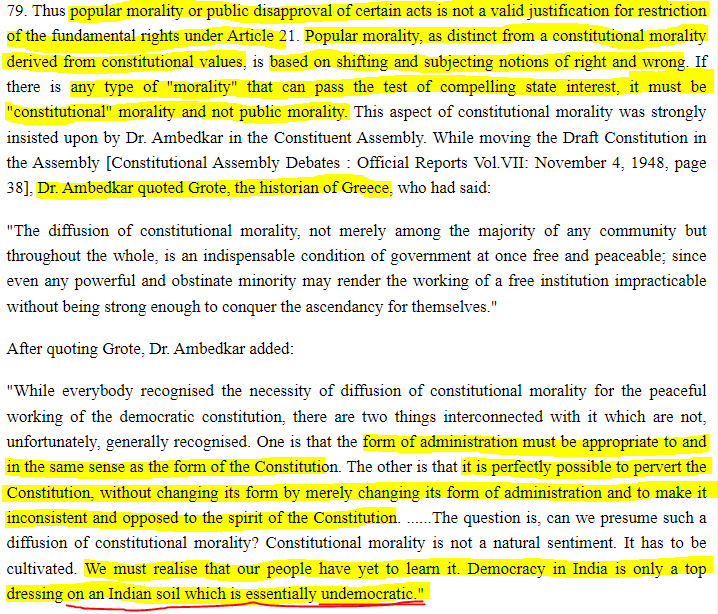
India was and is undemocratic and here came Dr. Ambedkar who along with the to-be justices in the future with their messianic interpretive morality would go ahead and define and install democracy in India for us idiotic Indians.
The Savior's burden laden comments of Delhi High Court and Dr. Ambedkar notwithstanding, the fact is that democracy was central to the Indian, more importantly, Hindu ethos far earlier than the Greeks had thought of it.
In Rig Veda (last Sukta of the 10th Mandala), Rishi Angiras offers his prayers to a special deity "Samajnana". Sayancharya, the great Vedic scholar during the Vijaynagar rule, called this deity - the keeper of "Collective, general and national consciousness of an entire people, the political consciousness which is spread evenly (Sambhavenu) among all classes, making up the total population of the country."
Samajnana really was the Deity of Democracy!
It was not just a system. Democracy was a way of being.
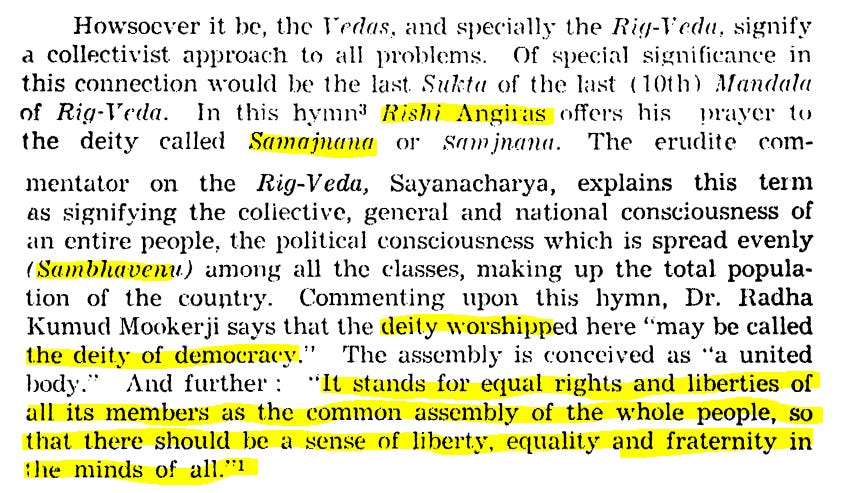
From Rig Veda, to the Arthasashtra, Manusmriti, the Mahabharata and Ramayana, and in the Puranas, the concepts of rule by Committee - which had the power to install, take out and reinstall Kings is a documented fact.
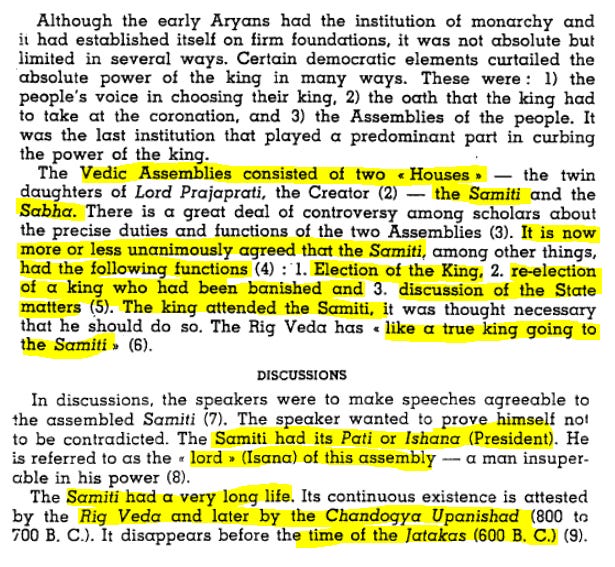
Here is a verse from Atharva Veda cited in the book "Village Panchayats in India" by HD Malaviya.
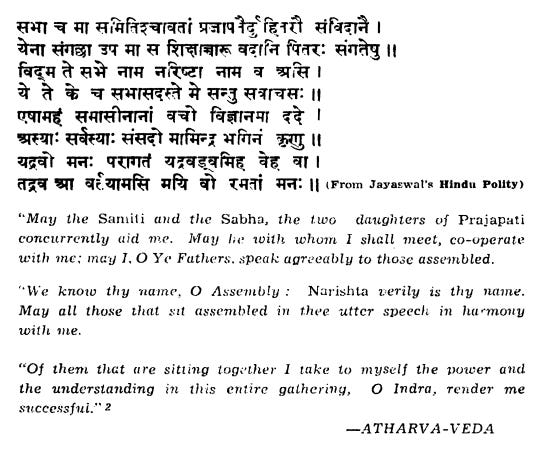
Malaviya laments how the Western Historians have created confusion in Indian history because they were on a "Civilizing mission" - the Messiah/Savior Complex! More importantly, the attempt by Western historians and sociologists to force-feed their maxims and structures on the very complex Indian systems was inappropriate at the least. It had deep coloniality import.
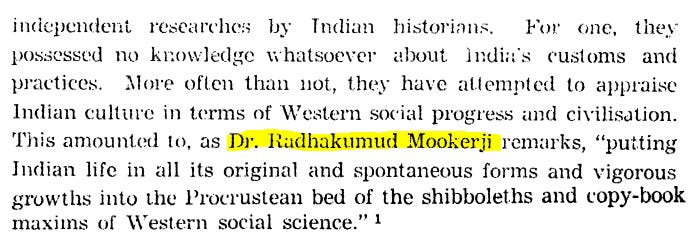
Let us ask the question that needs to be asked -
Has Indian judiciary been conceived and run by megalomaniacs with a strong Messiah Complex and (to borrow from the noted Indian historian Dr. Radhakumud Mookerji) eventually ended up creating a Procrustean Bed of social justice delivery system that has absolutely no relationship to the ground realities?
For a civilization and cultural ethos that not just created structures of democracy (long before the entire Western culture came about) but hoisted the very essence of democracy to the level of a Divinity - Samajnana - Deity of Democracy - to be lectured on how morality, as interpreted by a Johnny-come-lately to the civilizational horizon, is to help install a much-bastardized and watered-down version of democracy is not just laughable but downright egregious!
The question we asked - "Whose Morality is it anyway?" was actually posed by Chief Justice Ranjan Gogoi when a Supreme Court 5 member bench accepted that its September 28, 2018, judgment that lifting age restrictions on the entry of women into the Sabarimala hill shrine may impinge on the affairs of other religions too and needed a more detailed examination.
In turning to a larger Bench, three of the five judges on the Constitution Bench — Chief Justice of India Ranjan Gogoi, Justices A M Khanwilkar and Indu Malhotra — sought clarity on issues ranging from the essential religious practice test, including the “apparent conflict” between rulings in the Shirur Mutt case and Durgah Committee, Ajmer; entry into a mosque/durgah by Muslim women and into an agyari by Parsi women married to non-Parsis; the interplay between freedom of religion under Articles 25 and 26 of the Constitution and other provisions in Part III, particularly Article 14; and, the definition of constitutional morality. (Indian Express - Source)
Chief Justice Gogoi discussed the need to properly define the Constitutional Morality and its interplay or differentiation fro the public morality.

This is critical to the survival of Indian democracy.
For, in the eyes of the Indian citizens, Judiciary is one of the two most corrupt institutions in the country.
The Transparency International survey in 2006 done in South Asia was very instructive. It showed that in most countries in South Asia, after the Police, Judiciary is the second most corrupt institution. In India, both - the Police and the Judiciary - were probably on par when it came to corruption.
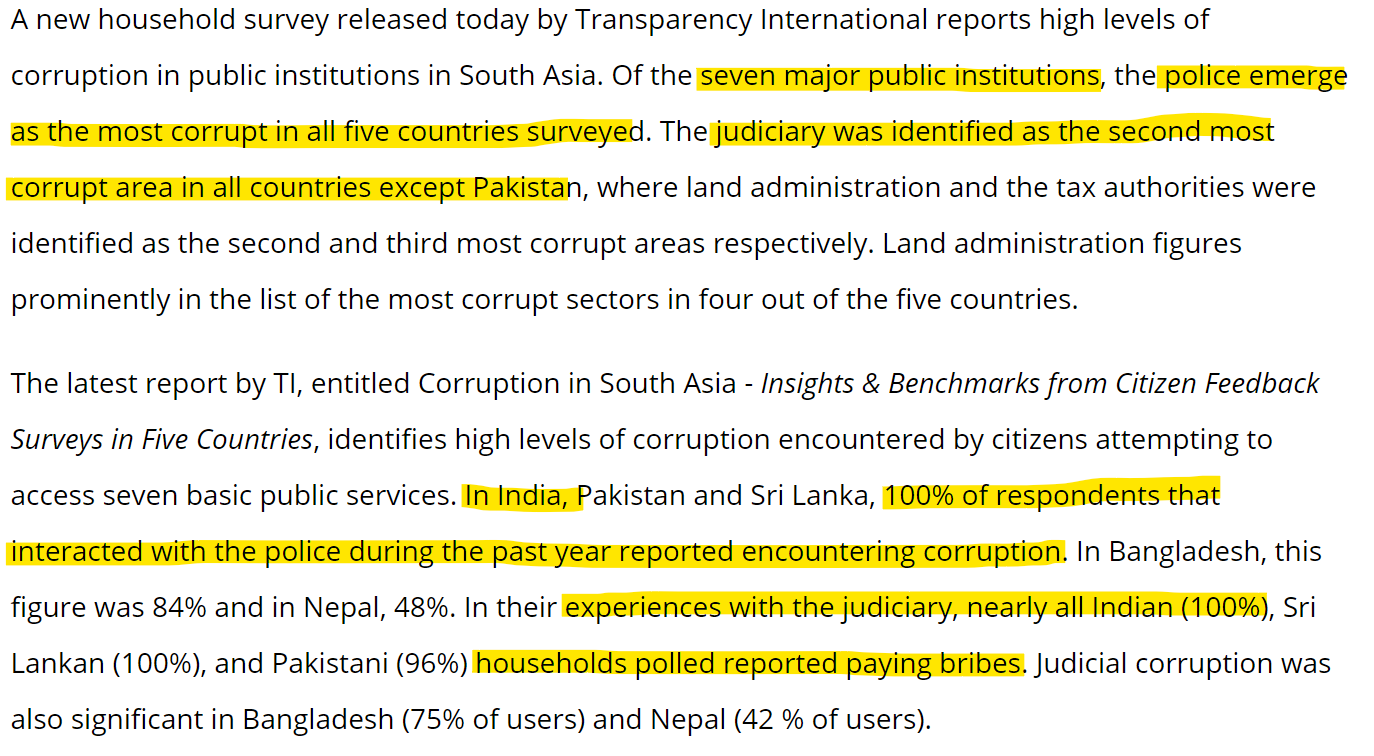
Central to this disenchantment with the Indian judiciary is how it has structured itself. Not the Indian public, the democratic norms, or the Constitution - but the Indian Judiciary, of its own accord, using its own powers has created a wall around itself. A wall that it does not allow anyone to penetrate. Breaking down the one element of democracy, which makes democracy a representational system of governance - Checks and Balances. Judiciary has taken the concept of Separation of Powers to such an extreme that it has smashed the concept of Checks and Balances to smithereens!
A wall against democratic Checks and Balances - the Collegium System
The Collegium System has little alignment with a democratic system. This system run as an "unaccountable opaque cabal" (Source) resembles more like the one which chooses a Pope!
The unique and curious Indian Judicial collegium system took shape and derived its strength from three Supreme Court judgments - which are collectively known as the “Three Judges Cases”. Even when the Indian Constitution does not refer to a Collegium system, the Indian judiciary created this system to shield itself from the executive and the legislature.
These cases were:
1981: S. P. Gupta v. Union of India or the “Judges’ Transfer Case (Source - India Kanoon)
1993: Supreme Court Advocates-on Record Association vs Union of India (Source - India Kanoon). Supreme Court held that “The process of appointment of Judges to the Supreme Court and the High Courts is an integrated ‘participatory consultative process’ for selecting the best and most suitable persons available for appointment; and all the constitutional functionaries must perform this duty collectively with a view primarily to reach an agreed decision, subserving the constitutional purpose, so that the occasion of primacy does not arise.” It held that no such appointments could be made unless it conforms with the opinion of the Chief Justice of India (CJI) (Source)
1998: In re Special Reference 1 of 1998 (Source - India Kanoon) This was not really a case. It was an opinion delivered by the Indian Supreme Court to President KR Narayanan who had, under his constitutional powers, raised a question on the collegium system.
The Rajya Sabha passed The Constitution(120th Amendment) bill, 2013, on September 5th, 2013 that amended articles 124(2) and 217(1) of the Constitution of India, 1950, and established the National Judicial Appointments Commission. A five-judge Constitution bench comprising justices J S Khehar, J Chelameswar M B Lokur, Kurian Joseph, and A K Goel unanimously declared that the 99th amendment to the Constitution to bring in the National Judicial Appointments Commission (NJAC) Act to replace the collegium system was unconstitutional. Thus closing any room for applying Checks and Balances to the Indian Judiciary system.
The problem is that this closed-loop that the Collegium system is - feeds on widespread nepotism.
Around 50% of the judges of high courts and 33% judges in the Supreme Court are family members of those in “higher echelons of judiciary”, claims a research done by a Mumbai-based lawyer. Advocate Mathews J Nedumpara, who is a petitioner-in-person, submitted the report to a five-judge constitutional bench hearing petitions challenging the NJAC Act. The situation was a result of the collegium system under which judges appointed other judges, Nedumpara told HT. (Source - Hindustan Times)
While pushing his weight behind the NJAC act, senior advocate Dushyant Dave had argued in 2018 as to how the Collegium system was destroying the Indian judiciary in furthering a system that rewarded ideological alignment creating an Echo chamber, where no dissent could be possible.
“There is no smoke without fire,” Dave said. “Some of the finest judges have been denied elevation (to the SC) for years as somebody in the collegium didn’t like him.” (Source)
This ideological echo chamber is not averse to letting go of its sense of equity and equality when it comes to what justice should really stand for and to whom. The "High and Mighty" get a pass, while the poor and lowly, the common man - waits for several decades for a simple judgment that often goes across generations!
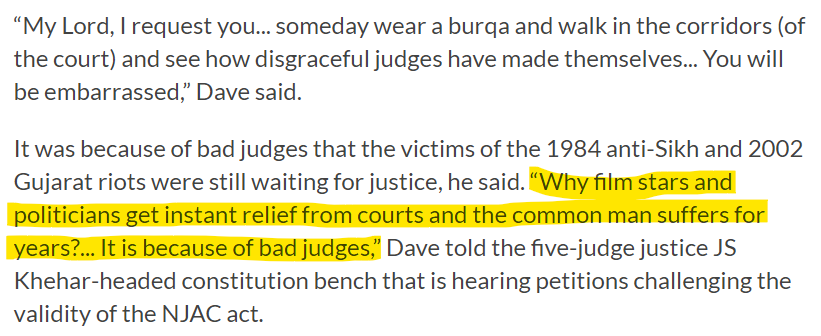
This is specifically important given the long history of how the judiciary has conducted itself.
Whispers of Judiciary's messy world
Here is some information curated from the book Supreme Whispers: Conversations with Judges of the Supreme Court of India 1980-89 by Abhinav Chandrachud (grandson of former Chief Justice YV Chandrachud and son of current Supreme Court judge Justice DY Chandrachud), article “How the Story of the Greatest Rivalry of the Supreme Court Unfolded” by Sanjoy Ghose, and other sources mentioned in the individual items.
Supreme Court Judge SC Roy took care of some personal work regarding the family property of Indira Gandhi in Allahabad. When he died shortly after assuming the office of the SC judge, a group of people swooped in to take away the files so nobody would know.
Per Chief Justice PN Bhagwati, a law minister (also a senior lawyer) had feigned heart trouble to get a case adjourned and then rushed to Delhi High Court to attend another.
One Chief Justice had vetoed the appointment of a serving High Court judge to the Supreme Court because of a credible sexual assault allegation. PM Indira Gandhi was very upset with him because this judge was related to a minister in her government.
In the 1980s, Chief Justice YV Chandrachud wanted to appoint the Chief Justice of Madras High Court to the Supreme Court. Indira Gandhi rejected the appointment because Justice Chandurkar had attended the funeral of RSS chief MS Golwalkar, who was a friend of the judge’s father. Just his attendance was deemed to make him ideologically unsuitable for appointment to Supreme Court.
A Collegium headed by Justice KG Balakrishnan and also having Justice Kapadia, Justice Markandey Katju had said in 2014, had almost succeeded in appointing a corrupt judge from Tamil Nadu to the Supreme Court. It was stopped when lawyers from Tamil Nadu produced "voluminous documentary evidence of his corruption." (Source - India Today)
Not just Justice Balakrishnan but two other former Chief Justices of India were accused of "improper compromises" in retaining a Tamil Nadu judge under corruption cloud during UPA rule, where DMK which had 18 MPs in the UPA I was the party putting pressure.
Chief Justice Konakuppakatil Gopinathan Balakrishnan himself was accused of being open to “fixing” cases for a consideration. Two former judges suspected this to be the case. Justice K Sukumaran and Kerala High Court Justice PK Shamsuddin accused Justice Balakrishnan of corruption. (Source - FirstPost) It is said that Chief Justice Balakrishnan had a political patron Kerala Chief Minister K Karunakaran. Although his nomination to the Supreme Court was rejected by the then Chief Justice, President KR Narayanan, a “fellow Dalit” insisted on the nomination! (Source - First Post)
A careful reading suggests that the Indian judiciary elite is not just self-serving and combative when it comes to fighting for their own family and friends, but have over the years, within those closed Echo Chambers reinforced by the impenetrable walls of the Collegium system, a strong ideological bias, and prejudice.
If we have had a system where a mere act of attending the funeral of an RSS Chief could deny a judge the seat on the table of the Indian Supreme Court, the ripple effects of such a history and the deep-seated ramifications in terms of political and ideological leanings, given the play of nepotism, favoritism and political quid-pro-quos could be devastating and loaded to one side!
And it is.
The Communist side had openly acknowledged influence. Justice Tarkunde, a judge of the Bombay High Court was an office-bearer of the Radical Humanist Party and had the Marxist radical extremist MN Roy as his mentor (Source).
Srivastava, with his socialist past is not the only judge with a political past. One judge of the Allahabad High Court had been a member of the Communist Party of India. Supreme Court's Justice Iyer was the law minister in the 1957 Communist-led ministry of E.M.S. Namboodripad in Kerala, and Tarkunde had been an office-bearer of the Radical Humanist Party. In addition, there have been several judges who had been active in the freedom movement. (Source - India Today)
The engagement of the Communist judges in shaping the Indian Constitutional law was discussed by Justice Muralidhar in 2021.
The Hon’ble Chief Justice was speaking at a performance organized on the 109th birthday of Viswanath Pasayat by the Viswanath Pasayat Memorial Committee. Justice Muralidhar aforementioned that Pasayat was someone who was viewed by some as a veteran communist and by several different as a socialist. “But what everybody seems to agree upon is that he took up the explanation for the poor. And if you look into the cases he argued, he argued an oversized variety of cases of preventive detention of political leaders,” he said. This, Justice Muralidhar said, made him wonder about the intersection of politics and law and the way contributions of persons like Pasayat and different socialists or communist lawyers haven’t been acknowledged. “I could press on with this list. Justice Pb Sawant belonged to Communist Party. Who will deny the large contribution that Justice Sawant created to the event of Constitutional law,” aforementioned Justice Muralidhar. The event was additionally attended by Supreme Court judge Justice UU Lalit and retired Supreme Court judge, Justice Rohinton Nariman. (Source - Lawtimesjournal)
So in Kashmir Files, when Professor Radhika Menon says "Sarkar kisi ki bhi ho, system to hamara hai," she is not too far off.
The old ideologies, narratives, mindsets, and ways that were "allowed" by the Congress rule within the Judicial system have ossified into the dominant lens within a closed-loop judiciary.
Creating the walls
Part of the reason for creating walls may have been the constant influence of the executive on the Indian judiciary system and appointments.
This came out most prominently during the two landmark cases - the Kesavananda Bharti case and the Habeas Corpus case.
Habeas Corpus Case - when the Judiciary capitulated
A five-member bench comprising Chief Justice A.N. Ray, and Justices H.R. Khanna, M.H. Beg, Y.V. Chandrachud, and PN Bhagwati decided one of the most controversial judgments in the history of the Supreme Court -the ADM Jabalpur v. Shivkant Shukla case (popularly referred to as the ADM Jabalpur case or the habeas corpus case). It was decreed that during the Emergency (1975 to 1977), a person's right to not be unlawfully detained (i.e. habeas corpus) can be suspended. In that fateful case, only one of the four judges on the bench dissented - Justice Hans Raj Khanna. He paid the price when he was superseded by Justice Beg, despite his seniority.
All of the judges who shamelessly went along with Indira Gandhi (and against the Indian citizens and Constitution!) on the annulment of fundamental rights of the Indian citizens enshrined in the Habeas Corpus rule ended up becoming the Chief Justices of the Indian Supreme Court.
Kesavananda Bharti Case - Season of Paybacks
The Chief Justice AN Ray was a controversial figure and one who was amenable to influence from the then PM Indira Gandhi (and her personal secretary - Source). His appointment as the Chief Justice came on the heels of the verdict in the Kesavanand Bharti case. Justice Ray superseded three senior judges - Supreme Court, Jaishanker Manilal Shelat, AN Grover, and K. S. Hegde.
✒️
“We have given you vast powers for the welfare of the country, but woe betide you if you misuse these powers”. Justice YV Chandrachud, while upholding the absolute amending power of the Parliament
Kesavanand Bharti case Bench: CJI S.M.Sikri, J.M.Shelat, K.S Hegade, A.N.Grover, A.N.Ray, P.Jaganmohan Reddy, D.G.Palekar, H.R. Khanna, K.K.Matthew, M.H.Beg, S.N.Dwivedi, A.K.Mukherjea, and Y.V.Chandrachud.
Majority: CJI Sikri and Justice Hegde and Mukherjea, Shelat and Grover, Jaganmohan Reddy and Khanna
Dissent: Justice Ray, Palekar, Mathew, Beg, Dwivedi, and Chandrachud.
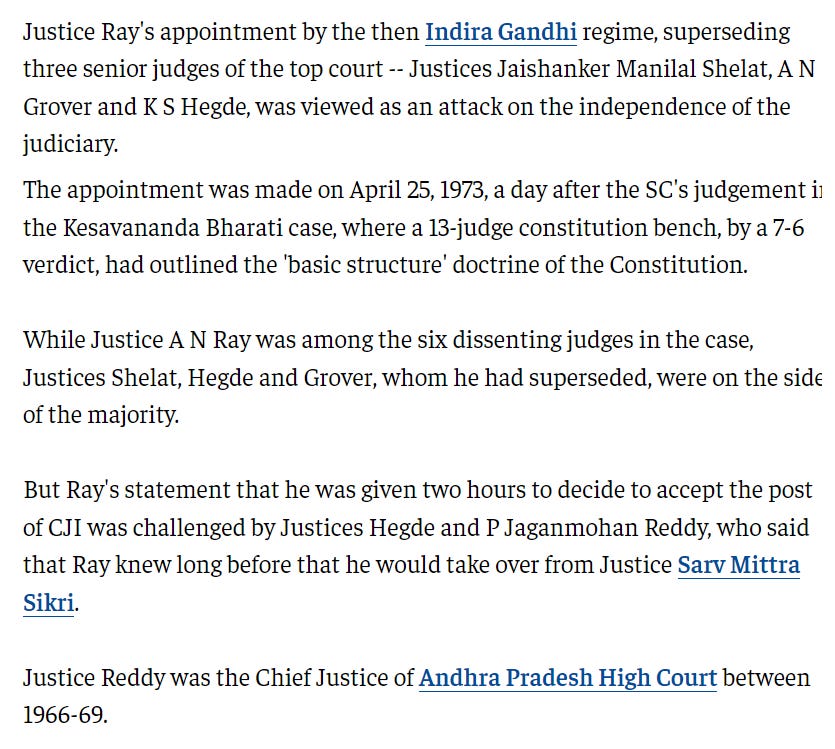
India's democracy cannot be free until all its pillars are answerable and accountable to the citizenry and not beholden to only the "High and Mighty" while being rigged by corruption, nepotism, elitism, and favoritism. When such an institution, with a debatable sense of culture, history, or theological bearings, becomes the deciding authority of the dominant social morality with no input from any group, then chaos, anarchy, and mess are the only future.
Video corner: Nahasdzáán
Earth is seen as a Mother and an extension of our own sense of being not just by the Hindus. But also by another set of indigenous people. The Navajo people - Natives of the American lands.
Nahasdzáán is the expression of the Navajo people that they use for Earth. The part - asdzáán, which takes on the meaning of woman, or female. In this sense, the earth is being referred to as taking on a motherly role, nurturing life and helping it develop. Their poetry and narrations with respect to Nahasdzáán have a strong commentary on the destruction of Earth with an attempt to bring healing to the mother.
Many of us do not know that the Navajo people prefer to be called the "Diné" meaning “The People” or “Children of the Holy People”. (Source)
If you like our content and value the work that we are doing, please do consider contributing to our expenses. CHOOSE THE USD EQUIVALENT AMOUNT you are comfortable with.
If you like this post - please share it with someone who will appreciate the information shared in this edition.
Today’s ONLINE PAPER: Check out today’s “The Drishtikone Daily” edition. - THE DRISHTIKONE DAILY




